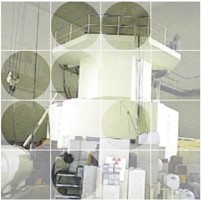
The Physical Institute, later to be re-named the Jožef Stefan Institute, was founded in 1949 by the Slovenian Academy for Science and Arts. Early research was devoted to the field of nuclear physics but, in keeping with the times, it was not long before the peaceful uses of atomic energy assumed an important place in the Institute's activities. In order to foster progress in this area, the Institute decided in 1960 to install a research reactor with a maximum continuous power output of 250 kW. The Reactor Department was established at the same time, the staff being responsible for research into reactor physics, with the aid of the betatron, for the interaction of radiation with matter, and for monitoring the construction of the research reactor, near Ljubljana.
The Institute has assumed responsibility for programmes of technical education and public awareness in areas related to radioactivity. The training of highly qualified personnel in reactor physics and engineering started in 1972 when the first courses were organized for the personnel of the NPP Krško. This activity was broadened when, in 1989, the Nuclear Training Centre was established by the Slovenian Electricity Utility. The main mission of this centre is to provide training of personnel for the NPP Krško, training in the area of radiation protection, organisation of international training courses in collaboration with the International Atomic Energy Agency (IAEA), and public information, particularly for school students.
|
Evolvement of research areas
REACTOR TECHNOLOGY AND ENERGETICS
The reactor TRIGA went critical on May 31, 1996. Laboratories for reactor physics, plasma research and nuclear chemistry were build round the reactor. It has been used for analysis of the dynamic and structural behaviour of solid materials and liquids using neutron elastic and inelastic scattering and neutron radiography. One of the main uses of the reactor is for chemical analyses, using neutron activation analysis. The reactor is used also to produce short lived radioisotopes for Slovenian industry, including zinc, bromine, cobalt and sodium, in addition to fluorine-18 and technetium-99m for use in hospitals. Between 1991 and 1993 the reactor was completely refurbished and upgraded to pulse mode operation.
The knowledge and expertise gained in the course of the basic and applied research in the field of reactor technology were invaluable when staff from the Reactor Centre became involved in planning, in the early seventies, for the nuclear power plant at Krško (NPP Krško). The many safety analyses needed for safe operation of the plant, the preliminary safety report and the assessment of the final safety were conducted by the staff members of the Reactor Centre. They also collaborated in the acceptance tests before the plant went into regular operation in 1982.
The Institute has made a significant contribution in the fields of reactor physics, engineering and safety. The latter necessarily depends to a considerable extent on sophisticated modelling of the reactor operation and possible faults. Topics include analyses of thermal and liquid flow systems and of power station structures with probabilistic safety assessments, the man-machine interface, modelling of molten fuel-coolant interaction and severe accident analyses. The research in reactor physics has been focussed mainly on new methods for power and research reactor calculations, where special attention has been given to the calibration and benchmarking of nuclear data and to computational methods. The results in the fields of nuclear safety and reactor physics are communicated to the Nuclear Safety Administration of Slovenia and elsewhere. Other main areas of work during the past years have included the study of nuclear tracks in solids, radiation damage research, neutron radiography and plasma physics. Every year since the initial startup of NPP Krško, the entire core design calculation for the NPP fuel cycle, start up physics tests, as well as many safety assessments have been performed as part of the Institute's involvement with the nuclear energy programme.
The research programme in the field of reactor technology provides the scientific environment for students to work for graduate, master's and doctoral degrees at the relevant University Faculties. In the Faculty for Mathematics and Physics a special postgraduate course on Nuclear Techniques, taught jointly with the Institute, has been established, resulting in many master's and doctoral degrees.
The research associated with the reactor has resulted in a number of interesting collateral developments. In the early days of computing, reactor physicists used the computer ZUSE to solve a neutron transport equation. In the begining of the seventies, the first on-line computer was installed at the research reactor for data logging and processing. This early computer control technology was transferred from the Institute for use in many industrial processes in Slovenia. In 1975, the first micro-computer system was developed and used for data logging on the research reactor, from which sprung a host of similar control systems in industry. Based on the significant experience gained in contract research implementing the use of computers, the Energy Efficiency Centre was established in the Institute to promote energy efficiency and decentralised energy supply.
|
